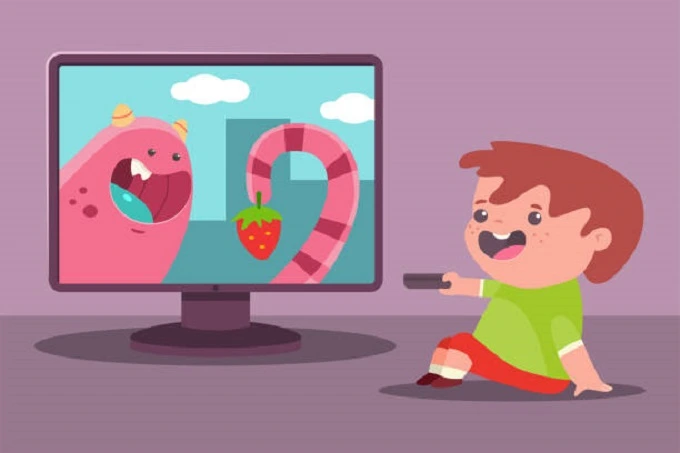Effect of cartoons on child development

The cartoons your children choose to watch may or may not be helpful. While some of them can set questionable role models, others can teach the appropriate values. You may learn more in this article about how a child’s mind can be influenced by cartoons and what you need to pay attention to when picking which ones to watch.
The positive effect of cartoons on child development

A child can gain both information and enjoyment from cartoons if they are picked out carefully. They also have many significant additional benefits to offer.
1. They educate
Exposing kids to the real world through cartoons is one more approach that might be taken. As an illustration of the device of things, for instance, several different kinds of animals and plants. In addition, to familiarize kids with the characteristics associated with the cultures of different nations.
In addition, children can get a head start on their education by watching cartoon lectures created just for infants and toddlers. They are free to discuss topics such as the alphabet, colors, and numbers.
And the list gets even longer when it comes to older children: for example, how to use household equipment correctly and be safe when walking on the road. In a format that the child finds interesting, they can also allow the children to study mathematics and other scientific topics further.
2. Develop language skills
Children improve their ability to communicate through language to the extent that they are exposed to literate and appropriate speech. They have a better voice and understanding of the words spoken by others. In addition, kids pick up on the appropriate tone by mimicking the voices of their favorite cartoon characters.
3. They contribute to a reduction in stress
Laughter is an excellent way for children to regain their positive feelings, and children will laugh at cartoons because of the comedic characters and scenarios. Endorphins are released when you laugh, and these endorphins assist you in dealing with the negative effects of stress. In addition to this, it boosts the immune system and generally contributes to overall better health.
4. Develop the ability to think
Children’s minds are helped to mature by watching cartoons, and they develop in you the skills needed to concentrate your attention and reason. Children’s visual and auditory processing skills can be improved with the help of music and the behaviors of their favorite characters. In addition to that, logic and reasoning can benefit from their usage.
5. Set a good example for others
Not all cartoons are capable of teaching kids valuable life lessons. But there are those characters who can pull it off.
For instance, a child might look up to their most admired scientist and aspire to have the same level of expertise as that person. This helps to contribute to a drive to study new things and discover more about the world.

Or, a child can identify with a character that is kind to others and has a lot of close friends; this kind of figure might serve as a model for him to follow while interacting with his peers and adults.
6. Improve their creative skills
Characters in numerous cartoons enthusiastically engage in dancing and singing. And the kid will want to figure out how to accomplish the same thing themselves. It improves skill sets as well as creativity.
In addition, many children who are captivated by particular figures choose to draw depictions of those characters. A child who is older and has access to the internet can look for tutorials online that will teach them how to acquire artistic methods and copy the figures they saw on television. And the smaller children try to combine the colors of his clothes and choose the ones acceptable for the picture.
At the same time, it’s possible that things won’t stop at simply copying the image; some kids come up with their own stories starring cartoon characters, demonstrating their creativity and fantasy.
Negative effects of cartoons

When selecting a cartoon for a kid, it’s essential to consider a few important considerations. If you don’t limit your exposure to them, cartoons could negatively affect them.
1. Can encourage disobedience
If a child sees a cartoon character that lacks self-control, is disrespectful to others, does not demonstrate empathy for those around them, or frequently indulges with no consequences, the child may want to emulate those behaviors.
Young children should not view these kinds of cartoons because they do not yet have the cognitive capacity to differentiate between correct and inappropriate behaviors. This may result in the children throwing tantrums and throwing “challenges” to their parents, who may choose to discipline the child for their conduct or explain to the child that what they want to achieve is impossible.
2. Contribute to the development of addiction
Addiction is a condition that can affect both adults and children. And also from comics and cartoons. They become agitated if they cannot watch a new episode or are forced to be sidetracked from watching cartoons to focus on more important matters.
Children may have a complete lack of interest in everything, save cartoons for their childhood. It is essential to keep a close eye on the amount of time a child spends in front of the television and encourage him to pursue other interests to prevent the kid from becoming an addiction.
3. The possibility that they might support violent behavior
There have been examples of cartoons presenting scenes with violent acts. For instance, one character can be beaten by another character, there can be explosions and buildings can be destroyed, there might be a desire for revenge, and there can be actions that make up for it.
If children watch violent cartoons regularly, especially at a young age, there is a greater potential that they may begin to view aggressive behavior as usual. This is especially true if children are exposed to cartoons early.
And in the same way, kids can use similar acts to their classmates and parents, such as trying to fight each other or engaging in dirty tricks that harm their health.
4. Encourage the use of inappropriate language
Several cartoons were not initially intended to be watched by children. They might have offensive language or just be filled with parasitic words. It is highly improbable that parents will desire for their children to expand their vocabularies in this manner. And because children are so easily influenced, it usually only takes them a few minutes to digest the information presented on the mat and begin incorporating it into their day-to-day lives.
As a result, it is essential to preview cartoons and decide on appropriate age ranges for them, in addition to exercising parental supervision over the programming choices the child makes when he watches cartoons on his own.
5. Display some examples of risky activity
A person who races across a street full of traffic or who jumps off a tall building and lands on his feet unscathed is hardly the greatest role model to look up to in real life. In addition, engaging in such behavior, especially repeatedly, puts them in a precarious position.
It is important to keep young children from watching these types of cartoons or to try to be with them when they are watching them so that you can adequately explain why it is impossible to behave in this manner in real life. Without proper supervision, the impulse to imitate can harm oneself or others, among other unfavorable effects.




